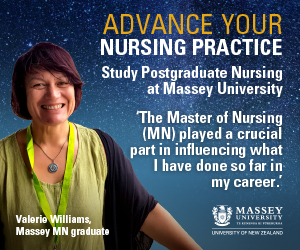The DHB offer currently being voted on by NZNO nurses includes 9-15.9% pay increases by 2020 as well as $38m for immediately recruiting an extra 500 nurses as a first step to address safe staffing concerns. Those extra nurses are expected to include new graduates but also experienced nurses from primary health and aged care sector nurses with DHBs also wanting experienced staff.
Dr Noeline Whitehead, an aged care nursing consultant, says the sector is extremely concerned that many of the extra RNs will be recruited from residential aged care, putting the sector at risk of being in a nursing staff crisis by Christmas.
Simon Wallace, chief executive of the New Zealand Aged Care Association, agrees there is a risk of a crisis with the aged care sector already facing close to 500 registered nurses vacancies across the country –equivalent to about 10 per cent of its RN workforce.
He said the sector had a major issue developing with the current RN shortage being compounded by two factors – the proposed DHB MECA’s call to recruit 500 extra nurses coming on top of the impact of immigration policy changes in 2016 that made it much harder to recruit nurses from overseas.
“We’re already seeing our nurses going to DHBs in anticipation of better pay and conditions – that happens anyway but is happening in more numbers right now.”
Whitehead agreed it was seeing an increased transition by RNs from aged care to the DHBs in anticipation of pay increases, with the turnover of RNs in the sector probably close to 35 to 40 per cent over the last 12 months. “I expect that is going to rapidly increase (once DHB nurse pay deal is agreed).”
“There appears to have been exactly no thought by the Government as to where these nurses are going to come from,” she said. Whitehead until late last year worked as a director of nursing in a residential aged care facility and continues as a board member of a retirement village company.
She said facility nurse managers are already struggling to find bureau staff to fill roster gaps. Pressured managers are asking RN staff to work extra shifts – or stay on site themselves – to meet contract requirements of having an RN on site. The difficulties were compounded by the requirements to have interRAI trained RNs and facilities committing to training nurses and “within months they are off to the DHB”.
Wallace said the association was about to put in a submission to the latest Essential Skills in Demand review for registered nurses to be put back on the Long Term Skill Shortage (LTSL) list. At the moment aged care nurses were only on the Immediate Skill Shortage List rather than the LTSL which was about sustained and ongoing shortages of RNs which was the sector was facing. Also the skilled migrant points changes made in 2016 were making things even more difficult to recruit overseas nurses. He said immigration was not the only answer to meeting RN shortages, but it had to be an option for the sector which was struggling to recruit New Zealanders in a low unemployment economy.
Pay relativity and Rymans pay increase
The impact of last year’s pay equity settlement for care and support workers also saw aged care sector RNs lose pay relativity with their caregiver co-workers.
Last week Rymans Healthcare chair Dr David Kerr said after last year’s well-deserved pay rises for caregivers it had been apparent that a substantial increase for nurses and other staff was also due. He said as a result its more than 500 experienced New Zealand nurses had been given an average pay increase of more than 20 per cent since last April which – combined with ‘reset’ rises for other staff – would cost an additional $5m over and above the Government’s 2% increase in government funding.
“We think the increases are necessary to reward everyone fairly, and to make sure we’re competitive. The new rates of pay make us one of the highest payers in the industry,” said Kerr.
David Wait, NZNO aged care industrial advisor said he was pleased that Ryman, which does not have a collective agreement with NZNO but does employ NZNO members, was paying the same rates – an increase on the current DHBs agreement base pay scale – that NZNO was claiming in bargaining for aged care nurses in 2018.
“What this shows is that large aged care providers with significant revenue from associated independent living villages can fairly pay their staff,” said Wait. “In the coming months, we will be negotiating with other large providers and this move by Ryman Healthcare will boost members expectations.”
Whitehead said large companies like Rymans had the ability to cross-subsidise retirement village profits to facilities but the small standalone facilities did not, and already struggled to compete with the DHBs current pay rates.
Wallace did not think pay relativity issues between RNs and caregivers after last year’s pay equity settlement was a major factor in current shortages but the pay gap with DHBs was.
He said DHBs made a commitment to the sector, after negotiating the latest Aged Residential Care funding contract in May, that it would return to the table once the DHBs and NZNO had finalised the new MECA (nursing collective agreement). “It implied they are prepared to come around the table and they are acknowledging that we have an issue with our nurses – and that’s important.” Wallace said he could not predict what the outcome of those post-MECA discussions would be.
Wait said the DHBs had agreed that if the NZNO collective bargaining with DHBs results in an increase significantly higher than 2% per annum, they would enter discussions about addressing any potential flow on pressure. “This means that more money may be available for aged care providers if they need to pay more to nurses as a result of the NZNO collective agreement with DHBs.”
Further DHB recruitment drives are also likely in the next two-to-three years as DHBs fulfil their commitment to implementing the Care Capacity Demand Management (CCDM) system of calculating the required nursing levels for every public hospital ward and unit.

























